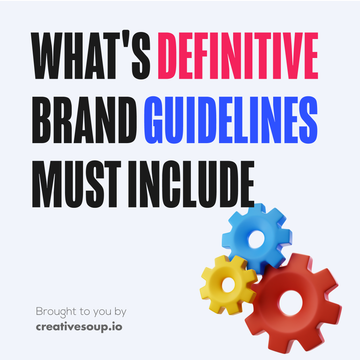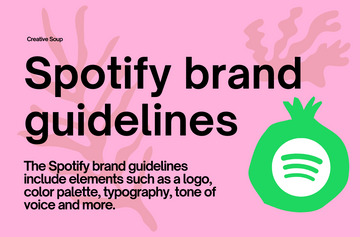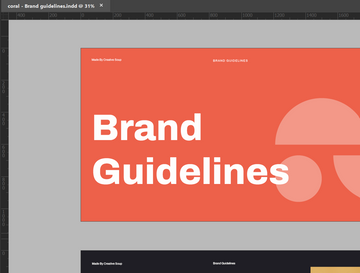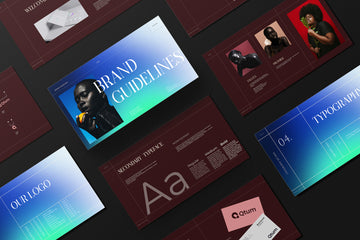One of the most if not the most important steps in the brand-building process is to create a brand guide. Just as the name implies, the Brand guide is the complete story of the brand and all the elements that go into it. It establishes strict guidelines on every aspect of how a company's brand will be managed and showcased.
When developing a brand identity, you should keep all of your brand elements in one handy document so that your employees and freelance contractors follow what is stated in the guideline.
Before you create a style guide, you must already have a deep understanding of your brand. key components: mission, Vision, Values, tone of voice, colors...
Brand Mission
“Where are we aiming to be?”
Your Brand Mission comprises who you are, what you do, and where you’re going or what you want to achieve. Typically, your Brand Mission is the reason why you are in the business and the purpose of your brand. The mission needs to clearly state that and it needs to align with the other aspects of your brand such as values, vision, tone of voice...
Mission Examples
Tesla Mission:
To accelerate the world’s transition to sustainable energy.
PayPal mission: To build the web’s most convenient, secure, cost-effective payment solution.
Brand vision
The brand vision is intention. It can be a single-minded intent, or a group of goals and objectives — typically no more than one, two, or three.
Your Brand Mission should answer the following questions:
What future do we want to help create? What does the future look like?
Vision Examples
Amazon’s “is to be earth’s most customer-centric company; to build a place where people can come to find and discover anything they might want to buy online.”
Microsoft :
Empower every person and every organization on the planet to achieve more
Uber :
Smarter transportation with fewer cars and greater access. Transportation that’s safer, cheaper, and more reliable; transportation
that creates more job opportunities and higher incomes for drivers.
Brand values
Brand values are the core beliefs of your brand, they are the pillars that hold your brand together. strong brand values are the foundation of a great brand. for a good example of brand values, look no further than Facebook, they embody their brand values more than most companies out there. their brand value consists of :
Focus on impact
. Move fast
. Be bold
. Be open
thus to create a great brand, make a set of brand values that truly represent the brand sets it apart from the competition, be clear and straight to the point without being too shallow or predictable.
A couple of questions to ask so you can figure out your brand values
Value Examples
Coca-cola
Leadership:
The courage to shape a better future.
Collaboration:
Leverage collective genius
Passion:
Committed in heart and mind
Diversity:
As inclusive as our brands
Tone of Voice
The tone of Voice describes how your brand communicates linguistically with the audience. the choice of words tone attitude is very important to define a strong tone of voice that truly defines your brand. are you targeting younger audiences? then you should be bolder and straight to the point? are you a professional brand? then you should be very formal in your communication. whatever your case might be you must define a tone of voice for your brand otherwise you'll sound exactly like the sea of a brand that sounds identical to one another. the following are question to ask when defining your tone of voice.
How do you use words to channel your Brand Values?
Funny or serious?
Formal or casual?
Respectful or irreverent?
Enthusiastic or matter of fact?
Basics brand guidelines
upon doing research on brand guidelines, one will mostly find a logo instead of a brand guide such as the example below
thus is logo guidelines, although it's fine and effective it's not a definitive brand guide,
the question is does that really define what truly what's brand guidelines are?

What's Definitive Brand guidelines includes
If you want to create brand guidelines, here is what's Brand Guidelines should include:
About company
Mission & Vision and values
Logo usage,
Proportions,
variation,
Clear space,
Minimum size
Full-Color Logo,
Logo on Backgrounds,
Logo on Photographs
Unacceptable Logo Use,
With Other Partner Logos
Primary colors, secondary colors
Typography includes Primary Design Typeface and Secondary design typeface
Photography style and Iconography
Tone of voice
Stationery letterhead, envelope, and business card design
Visual assets such as Pattern, illustration
Social Identity
Conclusion
Depending on the nature of your business or you client business a logo guide might be sufficient. however, if you want to make sure that your brand is consistent across all platforms and effectively communicated then you must invest your time, energy, and money and focus to develop a definitive brand guide. and in case you're facing troubles or missing important details, Creative soup got your back as we have created the definitive Brand Guidelines Template - Brandbold to help you solve this problem.






